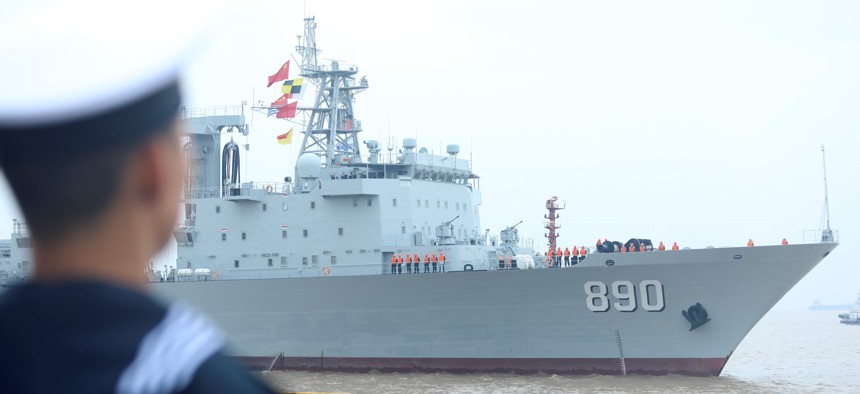
On Nov. 15, 2022, the supply ship Chaohu of the Chinese People's Liberation Army Navy returns to Zhoushan after helping to escort civilian vessels in the Gulf of Aden and off Somalia. Jiang Xia/Xinhua via Getty Images
Let’s Put the Pentagon’s China Report in Context
What do the relative sizes of the U.S. and Chinese nuclear arsenals really suggest?
The Pentagon released its annual report on Chinese military power this week, and hawks in Congress and the Pentagon will no doubt use it as evidence that China is on the march militarily, and that the U.S. should therefore continue its buildup in the Pacific and its development of a new generation of nuclear weapons. But a closer look at China’s military aspirations in the context of current U.S. capabilities tells a different story.
The report says that China likely possesses 400 nuclear warheads, and that if production stays on pace, the number could more than triple over the next decade. But the United States has over 5,400 warheads in its stockpile, including over 1,600 deployed on bombers, submarines, and long-range ballistic missiles. Even if the Pentagon’s assessment is correct, deterrence would hold; Beijing would be in no position to launch a nuclear strike on the United States or its allies without suffering a devastating attack in return.
Indeed, the disparity suggests that the Pentagon could forgo a significant portion of its three-decade, up-to-$2 trillion plan to build new nuclear-armed bombers, submarines, and missiles, along with new warheads to go with them. Instead of continuing a wasteful and destabilizing arms race, the United States could move towards a “deterrence-only” posture along the lines outlined by the organization Global Zero.
The greatest risk of a U.S.-China nuclear confrontation is escalation in a conventional conflict between the two countries. This suggests that preventing war, particularly over Taiwan, should be a top priority of U.S. policy. Earlier this week a Pentagon official told reporters that although China is building up its military, “I don’t see any kind of imminent indications of an invasion.”
This provides time and space to repair U.S.-Chinese political understandings and security perceptions concerning Taiwan. Recent statements by the Biden administration, coupled with visits to the island by high-ranking government officials such as House Speaker Nancy Pelosi, have undermined the “one China” policy, in which the U.S. forgoes formal recognition of Taiwan in exchange for a pledge by China to seek a non-military solution to the question of the island’s status. My Quincy Institute colleague Michael Swaine has further summarized the policy as follows: “the original Sino-U.S. understanding reached at the time of normalization…traded a U.S. acknowledgement of the Chinese stance that Taiwan is a part of China and an assertion that Washington would accept any uncoerced, peaceful resolution of the issue, for a Chinese adherence to a peaceful path toward unification as a top priority, while retaining the possibility of a use of force as a last resort.”
This approach has kept the peace in the Taiwan straits for decades, and a return to that approach is the best way to head off a future military confrontation. This arrangement does not preclude sending U.S. weapons that Taiwan could use to deter a Chinese attack.
Then there is the question of China’s global military ambitions. The Pentagon report cites China’s military base in the African nation of Djibouti and its possible plans to establish logistics hubs—not full-fledged military bases—in a handful of other nations. China’s moves should be contrasted with the U.S. global military footprint, which includes more than 750 military bases, 200,000 troops deployed abroad, and counterterror operations in at least 85 nations. China is in no position to match U.S. military reach, and the impact of its plans should not be overstated.
The real source of China’s global influence is economic, not military, from the Belt and Road Initiative, to its creation of an Asian development bank, to its growing trade ties with key nations. The Belt and Road Initiative is far from perfect. The infrastructure effort has raised questions of economic sustainability for participant nations, harm to the environment, and labor practices. But it is a significant source of influence nonetheless, and the United States has no comparable initiative.
Those who would seize on the latest Pentagon report on Chinese military power to bolster a militarized approach to U.S.-Chinese relations are doing America no favors. A more balanced approach that looks at political, economic, and military relations and seeks areas of cooperation on vital issues like combating climate change would be far more likely to foster stability and security for both the U.S. and China.
William D. Hartung is a senior research fellow at the Quincy Institute for Responsible Statecraft.